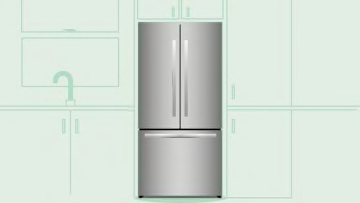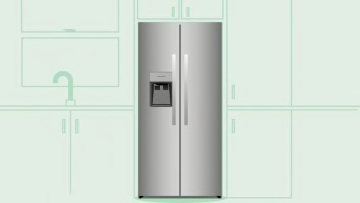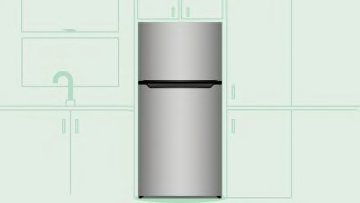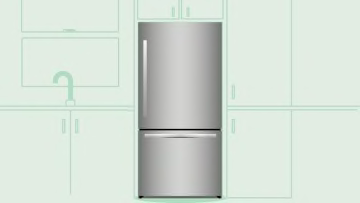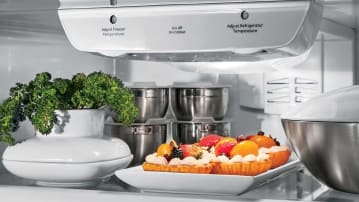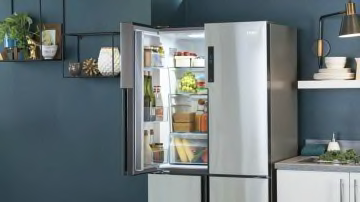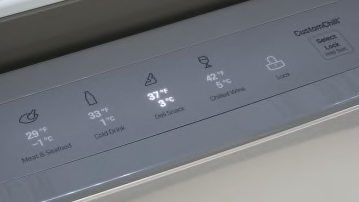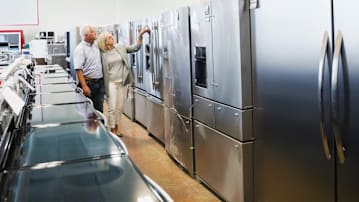Most Popular
Choose the Right Refrigerator for Your Kitchen
Our comprehensive guide will help you find a great refrigerator based on style, size, capacity, and features.
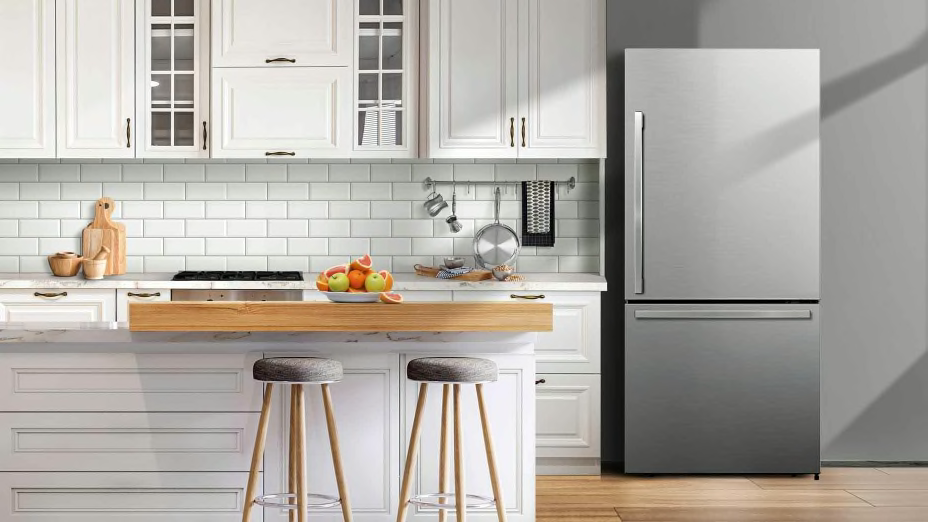
Photo: Hisense

Senior Home & Appliances Writer
Top Refrigerators Questions
Which type of refrigerator should I choose?
-
French-Door Refrigerators
Price $1,000-$5,000Widths 28-37 inchesCapacity Up to 31 cubic feetpros & consFrench-Door Refrigerators Ratings- Attractive and popular designs available
- Fresh-food doors need less space to swing open
- Actual storage capacities may be much less than claimed
- Tend to use more energy and cost more to run
-
Side-by-Side Refrigerators
Price $1,100-$2,500Widths 33-36 inchesCapacity Up to 29 cubic feetpros & consSide-by-Side Refrigerators Ratings- Narrow doors make them ideal for tight kitchens
- More features, such as icemakers and water dispensers
- Narrow freezers make it difficult to store wide items, like pizza boxes
- Not as energy- or space-efficient as other types of refrigerators
-
Top-Freezer Refrigerators
Price $500-$1,700Widths 22-33 inchesCapacity Up to 24 cubic feetpros & consTop-Freezer Refrigerators Ratings- Tend to offer the most space for their size
- Less expensive and more reliable than other types
- Doors need a wide space to swing open
- May lack features such as icemakers and water dispensers
-
Bottom-Freezer Refrigerators
Price $600-$2,900Widths 24-33 inchesCapacity Up to 26 cubic feetpros & consBottom-Freezer Refrigerators Ratings- Easy access to often-used fresh-food items
- May be more expensive and offer less storage than top-freezers
- Freezer bins require bending to access
- May lack features such as water dispensers
-
Built-In Refrigerators
Price $6,000-$20,000Widths 30-49 inchesCapacity Up to 29 cubic feetpros & consBuilt-In Refrigerators Ratings- Designed to sit flush with cabinetry and countertops for a luxury look
- Available in multiple configurations, such as column, side-by-side, and French-door
- Very expensive, especially compared with similar freestanding fridges
- Less interior storage space compared with other fridge types
-
Mini Fridges
Price $120-$260Widths 18-21 inchesCapacity Up to 3.5 cubic feetpros & consMini Fridges Ratings- Small size makes them easy to place in different areas, including a wet bar or home office
- Less expensive compared with full-sized refrigerators
- Rare to find a model where both the fridge and freezer compartments work well
- Few features beyond an interior light
How do I measure for a new refrigerator?
-
Measure the width of your refrigerator space:
Measure in several places to account for uneven walls, baseboards, and other trim. Subtract 1 inch on each side from your final measurements for ventilation.
-
Measure the height of your refrigerator space:
Measure in several places to account for uneven floors. Subtract 1 inch above the refrigerator for ventilation.
-
Measure the depth of your refrigerator space:
Some refrigerators can extend up to 10 inches beyond the countertop, so it’s good to keep depth in mind, especially in a small or narrow kitchen space. Allow at least 1 inch of space for airflow behind the refrigerator.
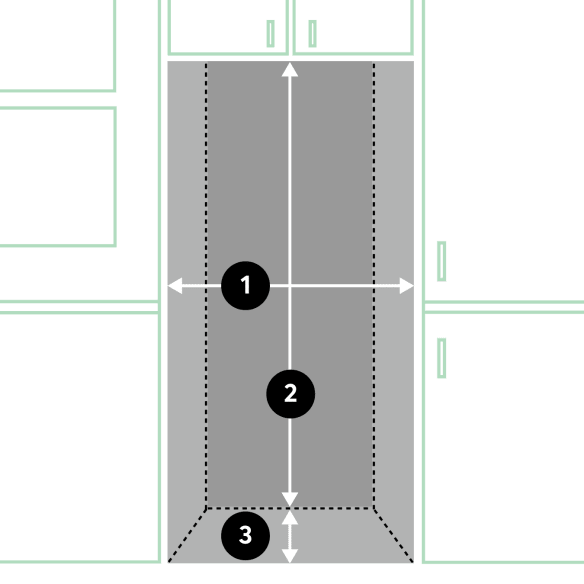
-
Certain widths are more common than others
Refrigerators are available in a variety of widths. Thirty-six inches is considered standard, but other common widths are 24 inches, 28 inches, 30 inches, and 33 inches. For built-ins, 42-inch and 48-inch widths are also available.
-
Counter-depth options
Refrigerators often extend up to 10 inches beyond cabinets. For a closer fit, consider a counter-depth model, although these will still stick out a few inches from your cabinetry. For a truly counter-depth fridge, consider a built-in.
-
Measure in front
Make sure there's room in front of the refrigerator for the doors to swing open, especially if your kitchen is narrow or has an island.
-
Plan a delivery path
Plot a pathway through your home that will allow the delivery of the new refrigerator into the kitchen area. It will need to fit through doorways and hallways.
How big a refrigerator should I buy?
Our refrigerator ratings are organized by width, allowing you to easily see the highest-rated models in the size that fits your space. You’ll find models ranging from a whopping 48 inches wide down to 24 inches for full-sized fridges and even narrower measurements for mini fridges. We also note the height and depth of each tested model.
To help you find the best refrigerators outside the standard dimensions, we have guides to the best counter-depth refrigerators, 24- to 28-inch-wide refrigerators, 30-inch-wide refrigerators, and 33-inch-wide refrigerators.
As for the ideal storage capacity, most refrigerator manufacturers recommend 19 to 22 cubic feet for a family of four. But if you do a big weekly shopping trip or buy in bulk, you may need more, up to 30 to 33 cubic feet. Note: Our tests have found that the amount of usable storage is often less than what’s claimed by manufacturers. Check our refrigerator ratings for the actual capacity of each model. And for the best large fridges from our ratings, see this guide to the best refrigerators for big families.
How do I know whether a refrigerator is energy-efficient?
-
Key features of the appliance and similar models that make up the cost comparison range.
-
The manufacturer, model, and capacity.
-
Estimated yearly operating cost (based on the national average electricity cost) and the range of operating costs for similar models.
-
Estimated yearly electricity consumption.
-
The Energy Star logo indicates that this model meets the program’s strict criteria for energy efficiency.

-
Look for the Energy Star label
The Environmental Protection Agency’s Energy Star label, which you can find at the bottom right of the EnergyGuide label, means that a product is in or around the top 25 percent of the market in terms of efficiency.
-
Efficiency varies by type
For example, a noncertified top-freezer refrigerator might be more efficient than an Energy Star certified French-door model.
-
Compare the annual operating costs
For an apples-to-apples comparison of which models are most efficient, look at the EnergyGuide labels of the refrigerators you’re considering, and compare the annual operating costs and the kilowatt-hours used per year.
-
Check the ratings
CR tests refrigerators for energy consumption. The energy a fridge consumes can add $50 to $60 per year to your energy bill, or more than $500 over the life of the unit. (Refrigerators should last about 10 years.)
What extra features should I know about?
-
Through-the-door ice and water dispenser
Photo: MaytagThis is one of the features most requested by buyers. But we've found that fridges with through-the-door water and ice dispensers require the most repairs. Energy costs are higher, too, and you sacrifice storage space.
-
Door-in-door storage access
Photo: GEWithout opening the entire door, you can grab frequently used beverages and condiments. That will save on energy costs in the long run. See the Best Door-in-Door Refrigerators from our tests.
-
Freshness features
Photo: GEDual evaporators help maintain higher humidity levels in the refrigerated areas and prevent freezer odors from migrating there. Air purifiers eliminate bacteria and mold spores, while vacuum-sealed crisper drawers are meant to keep food fresh longer. See “My Refrigerator Is Making Smelly Ice Cubes. What's Wrong?”
-
Better shelves and drawers
Photo: Consumer ReportsYou can rearrange split shelves to different heights independently. Elevator shelves crank up and down without you having to unload food. Shelf snuggers attach to racks to secure bottles and jars. Pullout shelves or bins make access to stored items easier, and they're a popular feature when shopping for ADA-compliant refrigerators.
-
Cameras and windows
Photo: ThermadorMany refrigerators now offer new ways to see inside without opening their doors. Internal cameras can be viewed from your smartphone when you’re out grocery shopping, while transparent windows help you spend less time browsing with the fridge doors open, letting precious cool air escape.
-
Counter-depth options
Photo: HaierA typical refrigerator can easily extend up to 10 inches beyond kitchen cabinets. Most counter-depth models stick out just a few inches past the countertop, providing a budget-friendly fit for smaller kitchens. See our guide to the “Best Counter-Depth Refrigerators.”
-
Specialty icemakers
Photo: SamsungYou don’t have to limit yourself to cubed or crushed ice. Some icemakers now create ice spheres or nugget ice for cocktails.
-
Temperature controls
Photo: LGYou decide how cold your fridge is in specific areas. For example, you can set a drawer to be cooler than the rest of the fridge to preserve meat, fish, and cold cuts better. Learn more with “Best Refrigerator Temperature to Keep Food Fresh.”
-
WiFi connectivity
Photo: SamsungMore new models, such as Samsung Bespoke fridges, come with WiFi connectivity and a companion smartphone app, allowing you to remotely change fridge settings, adjust internal temperatures, and receive alerts if a door is left open.
Who makes the most reliable refrigerators?
CR doesn’t just test refrigerators in our labs. We also survey our members about their experiences with refrigerators to gauge a brand’s performance over time. In our most recent surveys, CR members told us about more than 66,500 new refrigerators they purchased between 2014 and 2024. The refrigerator brands in the survey include Frigidaire, GE, Kenmore, KitchenAid, LG, Maytag, Samsung, and Whirlpool.
The results revealed that 33 percent of all refrigerators require repairs by the end of their fifth year of ownership, making them one of the least reliable appliances we analyze in our member surveys. The two most commonly reported problem areas for refrigerators are icemakers and dispensers. Top-freezers are more reliable than other types of refrigerators, including the coveted French-door style, but our members generally like top-freezers and side-by-sides less than other fridge types. (Our survey results don’t include mini fridges.)
To learn more about the survey results and sift through details across brands, check out our guide to the most and least reliable refrigerator brands.
Which brands make the best refrigerators?
We test dozens of refrigerators every year to add to CR’s refrigerator ratings, which currently have over 260 models. But there are still hundreds more on the market in a variety of styles, sizes, and finishes. To help you make a good purchase even if we haven’t tested the particular model you’re considering, CR created its first-ever brand scores for French-door, side-by-side, top-freezer, and built-in refrigerators.
The scores take into account our lab test results, reliability survey data, and the scope of a brand’s product line across different price and performance tiers. If you come across a particular fridge that isn’t in our ratings, these scores are a good indicator of how it will perform both when new and over time.
To see our complete brand scores, head over to our guide to the best refrigerator brands.
How should I shop for a new refrigerator?
-
It pays to wait for sales
Graphic: Consumer Reports, Getty ImagesIf your current refrigerator still works and you don’t need a new one right away, wait for sales events over major holidays, such as Veterans Day. Refrigerator prices tend to dip in the summer and hit their lowest point during Black Friday and Cyber Monday sales.
-
Compare prices
Illustration: Consumer Reports, Getty ImagesWe always recommend that you comparison shop. Don’t forget to check independent retailers, and don’t be afraid to ask for a discount. If you aren’t sure where to start, see our guides to the best appliance stores and shopping for large appliances.
-
Consider buying used
Photo: Getty ImagesIf you’re on a tight budget or you're simply looking for a good deal, consider buying a used refrigerator. You can get a higher-end model for a lot less than the retail price. The best places to look for used fridges are used-appliance stores and appliance repair shops. Both types of stores will usually give you a warranty, too. For more on purchasing used appliances, see our used-appliances guide.
Who handles refrigerator delivery, installation, and haul-away?
It’s important to check a retailer’s delivery and installation services before purchasing a new fridge. And if you’re replacing an old fridge, you might want to consider using the retailer’s haul-away service to remove and recycle the appliance.
Some retailers include those services with the appliance purchase for no additional charge, while others charge separate fees for them. For example, Costco generally offers all three services for free, while Best Buy charges $40 for delivery and installation, and an additional $50 for haul-away. Service fees can sometimes vary or be waived as part of a retailer’s sales promotion or if the refrigerator’s price is above a certain threshold.
You can find delivery, installation, and haul-away information for a handful of major appliance retailers here: Best Buy, Costco, Home Depot, Lowe’s, Menards, Sam’s Club.
After you purchase your new fridge, and as you approach delivery day, plot a clear path through your home for the delivery team to bring the appliance inside. Take measurements to ensure it will fit through doorways, hallways, and stairwells. Finally, if you’re replacing an old fridge, plan to have it cleaned out and disconnected before the delivery team arrives.
















